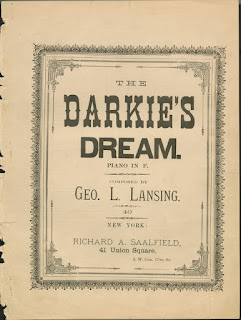(OH! I Love his Crooked bowtie!!!)
Since I haven't really spoken solely of one of my favourite early recording artists, Len Spencer, lately I wanted to get back into it for this post.
I had recently learned so much fascinating information from Jack Stanley on Youtube, going back and forth geeking out about all sorts of fascinating things having to to with the early recording business. I told him some new information, and he told me some new information. Here's a great video he put up that got us going on Len Spencer(make sure you read the comments!)
The one thing that really intrigued me about what he said was the fact that Spencer had a scar on his face from a knife fight. That was certainly something that got me exceedingly curious. So later I was told that is came from a fight he had in his youth, which was not the least bit surprising to me, as I'm sure he got into things like that often, even when he was older. I immediately looked through the old pictures I have of Spencer on my computer and in my geeky record books and couldn't pin down exactly where it was on his face. I have a feeling the picture above can give you a little hint if you look at it closely...
It was told that Ada Jones recalled the small thing later in her life in an interview, that was from most likely the late-teen's or early 20's(well, after Spencer croaked obviously). That was among the things she remembered about him? Apparently so. He was pretty beat-up and rugged when she started recording with him anyhow, so she only saw him in his later years(oh! if only Fred Hylands had lived longer!!).
We all know Spencer was a towering figure over his friends(even the freakish Fred Hylands!), at 6 foot 4 or 5, he looked intimidating compared to most of his fellow recording stars. He looked especially so after 1899, as that was when he got into the odd fad of bringing back the old ancient Greek and Roman physique(hence Eugene Sandow). That was when he looked especially menacing. That powerful and toned physique paired with his height, pale ivory skin, wide somewhat terrifying eyes, and graying black hair just made him all the more daunting.
(a piece of my art giving a literal representation of Spencer compared in height and overall size to Dan W. Quinn, around 1905-06)
Also a picture of him from c.1902:
Also a picture of him from c.1902:
Even with those eccentric looks of his, he was still the same old witty Len that he was back in the mid and late 1890's. He still had that fun and young personality he always had. By 1906, many of his friends from back in the late-90's had disappeared from recording, or were just about to, like Dan Quinn(pictured above). He hadn't all his old friends to go out and drink with like he used to, but he still had others by this time, as he was a renown stage owner and booking agent by this time, managing a business and whatnot. His daughters spoke of him later as a man who got more intimidating as he aged, and that he always towered over his family, save for his brother Henry(who was an inch or two shorter). He wasn't one to tangle with, whether when he was young or older, he was a freaky figure with an extremely sharp mind and observant eyes. This is where most of his sketched and monologues come from, as they were sometimes things that he went through himself, or he saw his friends or others get into. Such as this lovely one from 1901 that I just cannot get enough of:
Very Len Spencer indeed.
This is one of my favourite Len Spencer records, as the violin compliments his somewhat scratchy and peculiar voice. Also by the way that he shows off many shades of his voice and emotions, something that doesn't come out nearly as much as it does on this one. I also love those high-pitched moans he does!(such as that one at 0:37 to 0:41)
Many of his sketches were basically the same, but they were pretty funny and can be imagined well(if you know what they look like reasonably well) when you hear them, whether it be on the stage, or in the actual recording studio.
This one is always fun:
Ada Jones is especially good on this one. Spencer's all slow and steady with his words, groans, and sound effects ,as it's his creation, and he gets it perfect on this take. He did it earlier with Steve Porter, but that wasn't nearly as much fun. The record engineers complained about Porter doing all of the female voices for so many takes, so when Spencer brought in Ada Jones once again, they did it together and the record boys were just raving over how great it was.
The funny thing about this sketch is that I have the feeling that Spencer had this very situation come upon him before(as that was the case with the songs he wrote). Other than the thing at the end. It would not be surprising if that was the case. He would get home from recording and such drunk just as his character would be in the sketch. I just wish more of his hundreds of songs had survived the years, some of them must have been real funny ones, as what's left can prove that.
I hope you enjoyed this!









































